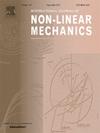螺栓在装配过程中和装配后的应力和摩擦演变
IF 3.2
3区 工程技术
Q2 MECHANICS
International Journal of Non-Linear Mechanics
Pub Date : 2025-05-06
DOI:10.1016/j.ijnonlinmec.2025.105132
引用次数: 0
摘要
由于配合面之间存在复杂的界面摩擦,螺纹连接内的应力分布非常复杂,这对拧紧力矩、旋转角度和轴向预紧力之间的耦合关系有重要影响。本研究建立了一个综合装配分析框架,其中包含三个关键因素:螺纹接触变形、螺杆体变形和装配过程中和装配后的摩擦分布演变。通过该模型,系统地识别了螺栓连接中三种不同的变形模式和相应的应力分布特征。随后的数值模拟定量地揭示了这些应力模式在不同操作条件下的产生机制。特别是,参数分析表明,减少刚度的夹具组件放大了旋转位移和轴向变形的紧固件。提出的方法进一步阐明了装配后预紧松弛现象的机制。通过准静态测试进行的实验验证证实了扭矩-预紧力-角度参数的测量一致性,理论预测与实验数据具有良好的一致性。这一分析进展提高了对螺栓连接力学的基本理解,同时为精密装配和结构安全评估的工程应用提供了理论指导。本文章由计算机程序翻译,如有差异,请以英文原文为准。
Stress and friction evolution in the bolt during and after assembly
The stress distribution within threaded connections exhibits significant complexity attributable to the intricate interfacial friction between mating surfaces, which critically influences the coupled relationship among tightening torque, rotational angle, and axial preload. This study establishes a comprehensive assembly analytical framework incorporating three critical factors: thread contact deformation, screw body distortion, and frictional distribution evolution during and after assembly processes. Through this model, three distinct deformation patterns and corresponding stress distribution characteristics in bolted joints have been systematically identified. Subsequent numerical simulations quantitatively reveal the generation mechanisms of these stress patterns under varying operational conditions. Particularly, parametric analysis demonstrates that reduced stiffness of clamped components amplifies both rotational displacement and axial deformation of fasteners. The proposed methodology further elucidates the mechanism underlying post-assembly preload relaxation phenomena. Experimental validation through quasi-static testing confirms measurement consistency across torque-preload-angle parameters, with theoretical predictions showing excellent consistency with experimental data. This analytical advancement enhances fundamental understanding of bolted joint mechanics while providing theoretical guidance for engineering applications in precision assembly and structural safety assessment.
求助全文
通过发布文献求助,成功后即可免费获取论文全文。
去求助
来源期刊
CiteScore
5.50
自引率
9.40%
发文量
192
审稿时长
67 days
期刊介绍:
The International Journal of Non-Linear Mechanics provides a specific medium for dissemination of high-quality research results in the various areas of theoretical, applied, and experimental mechanics of solids, fluids, structures, and systems where the phenomena are inherently non-linear.
The journal brings together original results in non-linear problems in elasticity, plasticity, dynamics, vibrations, wave-propagation, rheology, fluid-structure interaction systems, stability, biomechanics, micro- and nano-structures, materials, metamaterials, and in other diverse areas.
Papers may be analytical, computational or experimental in nature. Treatments of non-linear differential equations wherein solutions and properties of solutions are emphasized but physical aspects are not adequately relevant, will not be considered for possible publication. Both deterministic and stochastic approaches are fostered. Contributions pertaining to both established and emerging fields are encouraged.

 求助内容:
求助内容: 应助结果提醒方式:
应助结果提醒方式:


